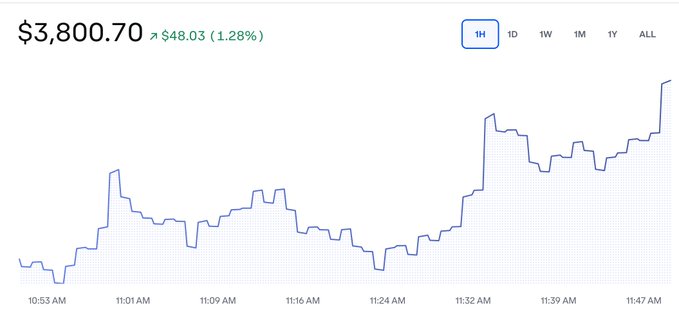Eight wallets that hadn’t moved Bitcoin since the cryptocurrency’s earliest days suddenly transferred $8.6 billion last week. The timing however coincided with Bitcoin hitting $122,000 and Trump signing the first major U.S. crypto legislation into law.
The whale movements weren’t coincidental. These wallets, untouched since Bitcoin’s inception, represent some of the largest individual holdings from the Satoshi era. One Satoshi-era whale moved 40,000 BTC valued at $4.77 billion directly to Galaxy Digital on July 17, with the asset manager immediately routing $236 million to exchanges including Binance and Bybit.
As Bitcoin reached its all-time high of $122,000 on July 14, President Trump signed the GENIUS act into law on July 18. The legislation, which passed the House with bipartisan support in a 308-122 vote, represents the first major cryptocurrency regulatory framework in U.S. history.
Legislative momentum drives institutional confidence
The timing reveals calculated market dynamics. Trump’s administration designated July 14–18 as “Crypto Week,” with Congress advancing multiple bills, including the CLARITY act and Anti-CBDC Surveillance State Act. But the centerpiece was the GENIUS act, which President Trump officially signed into law on Friday, July 18, fulfilling his campaign pledge to make the U.S. a global crypto capital.
The GENIUS act marks the first federal legislation for stablecoins, requiring issuers to maintain full one-to-one reserves, submit to regular audits, and comply with anti-money laundering protocols. SEC Chair Paul Atkins called it a “monumental step forward,” while Trump himself described it as “a revolution in financial technology.”
That same day, Ether crossed $3,500, and Bitcoin hovered near $118,000, reflecting investor confidence in the legitimacy the new law conferred. At the bill signing, Trump also issued a presidential directive retiring the previous administration’s executive order that limited crypto-related financial partnerships between U.S. banks and fintech firms—effectively clearing another roadblock to adoption.
The GENIUS act directly targets the $238 billion stablecoin market and paves the way for banks and companies to issue compliant digital currencies. Bitcoin ETFs, now a cornerstone of institutional exposure, have absorbed $15 billion in inflows over recent weeks, creating the liquidity depth needed to process whale-sized movements without destabilising the market.

Market correction follows whale exodus
The whale activity triggered immediate market volatility. Bitcoin dropped below $117,000 by July 19, reaching an intraday low of $116,218 as traders interpreted the transfers as potential sell pressure. The correction intensified when Galaxy Digital began depositing portions of the newly received coins to major exchanges.
Still, the dip came after a historic surge. The current bull run, which began in April 2025 when Bitcoin broke above $94,000 amid easing trade tensions with China, has now stretched nearly 30% higher in just three months. That rally marked 12 months post-halving—typically a key point in Bitcoin cycles—but unlike previous ones driven by retail FOMO, this one is deeply institutional. ETF inflows, clearer regulation, and corporate treasury adoption are now the dominant forces behind upward momentum.
Despite the volatility, institutional demand remained resilient. Bitcoin ETFs recorded their 11th consecutive day of net inflows on July 19, absorbing $522 million in new capital. Professional investors appear to view the whale movements as strategic profit-taking, not a breakdown of market fundamentals.
The broader crypto market is reflecting that same confidence. Ethereum crossed $3,800 for the first time since February 2024, signaling the start of what some traders are calling an altcoin season. Community sentiment has shifted toward tokens like ADA, XRP, HBAR, DOG, and XDC, as capital begins rotating beyond Bitcoin.

Market analysts see the smooth absorption of these multi-billion-dollar transfers—without panic or liquidity crunches—as a sign of a maturing market. Bitcoin has consolidated near $118,000 after briefly touching $123,200, and the overall market is beginning to reflect both depth and diversification.
Global implications
The GENIUS Act’s impact extends beyond U.S. borders. African nations, where Nigeria ranks second globally in cryptocurrency adoption with $59 billion in transactions from July 2023 to June 2024, could benefit from stablecoin regulatory clarity. The framework could lower remittance costs and encourage regulatory alignment across African markets.
South Africa is implementing the Travel Rule by April 2025 to combat financial crimes, while events like Blockchain Africa Conference 2025 highlight growing continental interest. The regulatory framework could attract investment to Africa’s blockchain sector, though misalignment with U.S. standards might create competitive challenges for local crypto businesses.
Market maturation signals
The whale movements signal something beyond typical profit-taking. When holders worth $8.6 billion start moving assets after 14 years of dormancy, it suggests these early adopters see fundamental shifts in market structure. The regulatory framework may have provided the institutional confidence needed for them to finally liquidate or reposition holdings accumulated when Bitcoin traded below $4.
The question isn’t whether more whales will follow suit, but whether the market can absorb continued selling pressure while maintaining institutional confidence. With Bitcoin ETFs still drawing hundreds of millions weekly and altcoin momentum building, the current correction may represent healthy profit-taking rather than the end of the bull cycle.
Get passive updates on African tech & startups
View and choose the stories to interact with on our WhatsApp Channel
Explore




